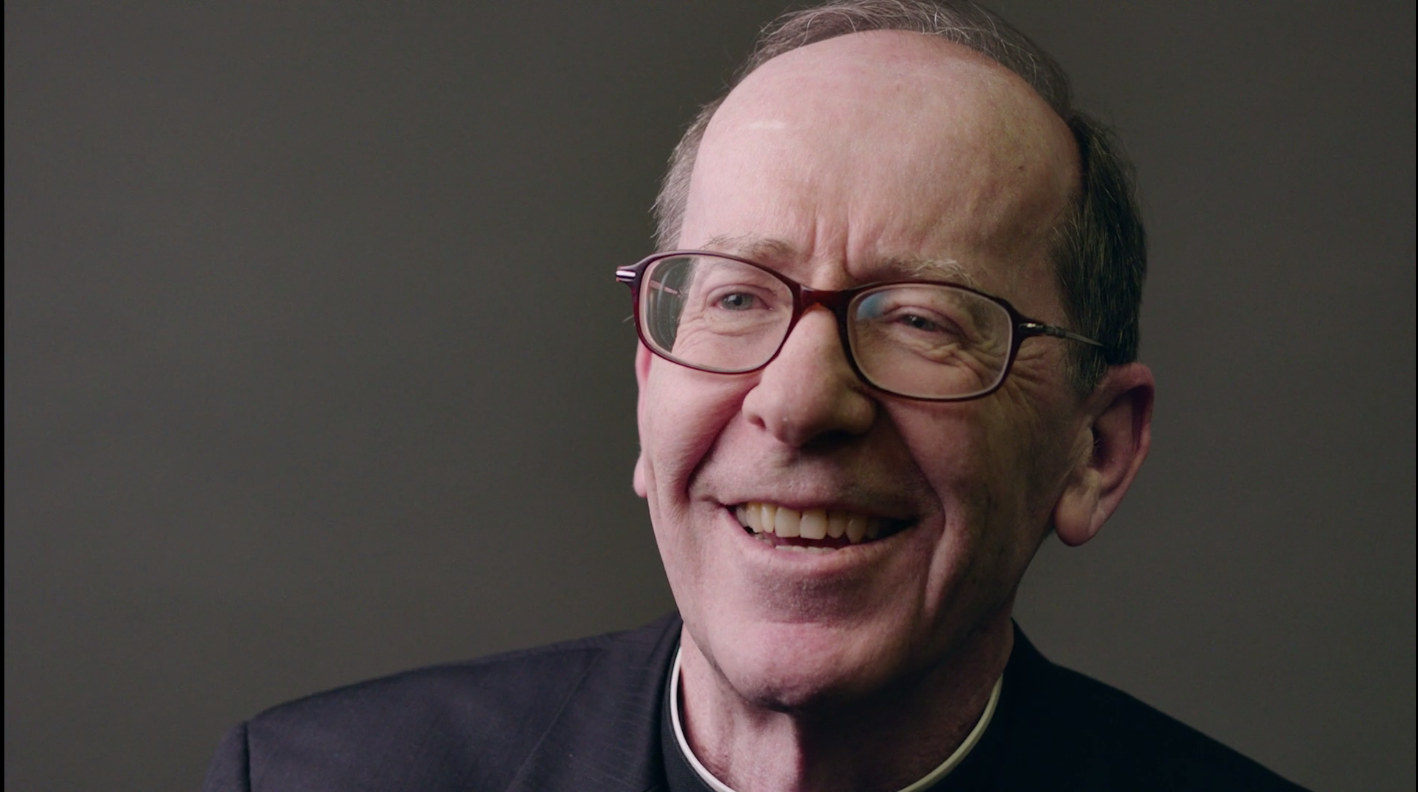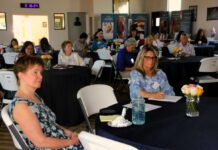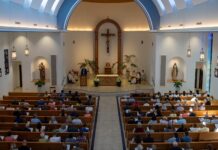By Jeff Grant, The Catholic Sun
“He shepherded them with a pure heart; with skilled hands he guided them.” (Psalm 78:72)
PHOENIX — With Friday’s announcement that Pope Francis has accepted the resignation of Bishop Thomas J. Olmsted, 75, and appointed Diocese of San Diego Auxiliary Bishop John P. Dolan to lead the Diocese of Phoenix, diocesan officials and laity began preparing for a new shepherd to succeed one whose characteristics embody, many of those individuals say, the description of King David, “a man after God’s own heart.”
The Holy See appointed Olmsted the fourth Bishop of Phoenix on Nov. 25, 2003. He had been serving as Bishop of the Diocese of Wichita, Kan. When asked by The Catholic Advance, Wichita’s diocesan newspaper, why he thought he was appointed to the Phoenix post, Bishop Olmsted’s answer was typically self-effacing:
“I really don’t know why I was asked,” the newspaper quoted him. “I think it would be linked with the fact that the Diocese of Wichita is a really good diocese. And because of that, it looks like I’m doing OK as a bishop.”
The answer reflected a self-view rooted deeply in faith in Jesus Christ, the Blessed Mother, and the teachings of the Church, a view that anchored and guided Bishop Olmsted throughout his more than 18 years as shepherd of the nation’s fifth-largest diocese.
“He is humble, committed to the Lord. It is evidenced in his prayer and the way he walks: He is generous in his own giving and embraces priestly poverty in a way that doesn’t often happen,” said Fr. Fred Adamson, the Phoenix Diocese vicar general and moderator of the curia. “He also possesses a clear sense of culture and wisdom; how we are moving through some unique times and how the Church is moving through it,” he added.
One of several top assistants to the bishop, Fr. Adamson has served nearly 18 years in the post. The vicar general assists the bishop in the administration of the diocese; as moderator of the curia, under the bishop’s authority, he coordinates the exercise of administrative duties and oversees those who hold offices and minister in diocesan administration.
Chancellor Dr. Maria Chavira, another member of the Diocesan leadership team, said of the bishop, “He really is what people say is a servant leader. He is one of the most humble people I have ever met.”
Responsible for gathering, arranging, and safeguarding the acts and archives of the diocesan curia, the chancellor also helps disseminate information to clergy, parishes and the Catholic faithful that may be beneficial to the people of the Diocese. Dr. Chavira has served in the role for almost nine years.
Her description of the bishop can leave one with a sense that if he or she were to meet Bishop Olmsted in a small restaurant in a tiny town in the middle of Arizona’s broad expanse, and did not know who he was, they would encounter someone deeply interested in that individual and his or her eternal destiny.
MIDWEST ROOTS, STAY IN ROME
Thomas James Olmsted grew up on a farm near the Kansas-Nebraska border with five brothers and sisters. He attended a single-room grade school near Oketo, Kan., and a small rural high school in Summerfield, Kan. His first contact with Catholic schools came when he entered St. Thomas Seminary College in Denver, where he graduated in 1969 with a bachelor’s degree in philosophy.
He was ordained a priest July 2, 1973, for the Diocese of Lincoln, Neb., and joined the Jesus Caritas priestly fraternity shortly thereafter.
After three years as associate pastor at the Cathedral of the Risen Christ Parish in Lincoln, Fr. Olmsted moved to Rome, where he studied at the Pontifical Gregorian University, earning his doctorate in Canon Law summa cum laude in 1981. He remained in Rome, where he served as assistant to the Secretariat of State of the Holy See under St. John Paul II and assistant spiritual director at the Pontifical North American College for 9 years. While there, he also assisted seminarians with spiritual direction.
Upon his return to the United States, he took a 6-month sabbatical before moving onto parish ministry. In 1989, he was named pastor of St. Vincent de Paul Parish in Seward and promoter of justice for the diocesan tribunal. In 1993, he was appointed to the Pontifical College Josephinum in Columbus, Ohio, where he served as dean of personal formation before being named rector. He was ordained as coadjutor bishop of the Diocese of Wichita in 1999.
MEETING A TROUBLED TIME HEAD-ON
When the Holy See appointed Bishop Olmsted to Phoenix, his predecessor, Bishop Thomas J. O’Brien, was facing charges for fleeing the scene of a fatal car accident. He resigned days after that incident.
Earlier in the year, Bishop O’Brien signed an agreement with the Maricopa County Attorney’s office in which he admitted to protecting priests accused of sexual indiscretions with children.
In his installation homily, Bishop Olmsted said that Christ’s transformative love “impels us to face the scandal of child abuse squarely and to combat it with honesty and determination.”
He was quoted in a Catholic Sun article at the time as saying, “A bishop is to be a father and a brother to his priests.”
The new bishop lived that belief upon his arrival.
Rather than move into the Bishop’s House, he opted to let O’Brien stay there. Bishop Olmsted instead took a room at the rectory at Ss. Simon and Jude, the diocesan Cathedral parish, a choice that allowed him to live with his brother priests. When he was offered the largest bedroom, though it was occupied at the time, he requested the vacant, smaller one.
“That’s the one that’s available,” he is said to have responded. “I’ll take that one.”
“He could have had things a lot differently,” said Dr. Chavira, “but he didn’t.”
Bishop Olmsted immediately began making personal visits each week to all 90-plus parishes, reassuring pastors and their staffs, as well as the laity, that everything in the Phoenix Diocese would be all right despite the scandals.
He also wanted to get to know those he would serve and labor alongside.
Dcn. Doug Bogart, who was ordained in 2004 and now serves as Associate Director of Education and Formation for the Office of the Diaconate, recalls their first encounter that spring as the deacon class was going through formation.
“We had a class in Lake Havasu City, and he came, just to get to know us. He asked about us, our marriages, our kids. That had never happened before in all the ordinations I had. He spent the day with us. I found that to be a clear sign of his character and his desire to know those people he was going to be collaborating with as deacons. That spoke volumes.”
Dcn. Roy Drapeau, who now serves at the Cathedral, recalls meeting the bishop over 17 years ago when he was a deacon at St. Thomas More Parish in Glendale. Dcn. Drapeau’s pastor at the time, Fr. Jim Turner, asked Dcn. Drapeau and his wife to host the bishop for dinner at their house.
“Something that night stuck out,” Dcn. Drapeau recalled. “My wife and I came from large families, and we had a lot of pictures around the house. He would look at the different ones and ask questions. His attention to detail was amazing. Fast forward 10 years later, I was transferred to a different parish, St. James, also in Glendale. Bishop was there, and the pastor asked us (also) to host a dinner. “(Bishop) was telling everyone, ‘You’re going to love going to Terry’s house,’ then he proceeded to recall for them what he had (eaten) 10 years earlier.”
LISTENING TO THE FLOCK
Dcn. Drapeau said the bishop still makes a concerted effort to interact with the flock.
“He has always told me his job is to be with the people. Monday is technically his day off, but there have been many Mondays when he went to Masses or other events. It amazes me how he will greet people and recall what they prayed about last year.”
Others agreed.
“He listens. He listens deeply. When someone is speaking, he gives them his full attention. It’s a true discernment process,” said Dr. Chavira.
“I learned to step back (when with the Bishop),” explained Fr. Adamson.
“If he’s with someone, he doesn’t want to be moved along. He is always eager to meet people. He is an authentic shepherd of people and a father, and has a desire to see the faithful in a true fatherly role.”
Bishop Olmsted also brought to the Diocese a sense of global connection to affairs of the Catholic Church to help the faithful understand why what happens in Phoenix matters beyond its borders.
“He has helped us understand we are part of something much bigger. You’ll notice how often he links what he’s saying to the Holy Father. He has a deep understanding of our relationship and his to the Holy Father,” Fr. Adamson explained.
During his tenure, Bishop Olmsted has delivered several Apostolic Exhortations, including “Complete my Joy,” to husbands, wife, mothers and fathers; “Veneremur Cernui – Down in Adoration Falling,” to priests, deacons, religious and the lay faithful of the Diocese of Phoenix on the Sacrament of the Holy Eucharist; and “Into the Breach,” to Catholic men.
Review a complete list of Bishop Olmsted’s Letters, Columns and Exhortations
NAVIGATING STORMS
Bishop Olmsted was described by his colleagues as an effective leader because he delegates efficiently but also communicates well while making sure he is kept up to date.
But in late 2009, about seven years after arriving, the Bishop stood alone under the weight and in the glare of public scrutiny, when he took the reins of a problem many consider one of his and the diocese’s most significant challenges during his tenure.
That November, an abortion was performed at St. Joseph’s Hospital and Medical Center in Phoenix on a woman who was 11 weeks pregnant and suffering from pulmonary hypertension. The procedure took place after being authorized by an 11-member ethics committee. “In this tragic case, the treatment necessary to save the mother’s life required the termination of an 11-week pregnancy,” the hospital said in its statement.
The ethics panel included Sr. Margaret McBride, a member of the international community Sisters of Mercy.
After learning of and thoroughly reviewing the decision, the bishop advised Sr. Margaret she faced excommunication. He cited Canon 1398, which states those who participate in an abortion incur an automatic excommunication. He was supported in his decision by the U.S. Conference of Catholic Bishops Committee on Doctrine.
The bishop later declared St. Joseph Hospital was no longer Catholic, though he returned the Eucharist to the hospital chapel in 2020.
While the decision angered some, it stands as perhaps one of the best-known examples of Bishop Olmsted’s commitment to Church teaching. It also reflects his devotion to reflecting God’s love for others, even those viewed as making wrong decisions, according to colleagues.
“It might be difficult to digest or controversial, but he will stand for the truth, no matter what it is or what the cost will be,” said Dr. Chavira, the diocesan chancellor.
‘IT’S BEEN A GIFT’
“He may have a hard time with something someone is doing, but he’s not going to demean the character of someone who’s making those choices,” said Dcn. Bogart. “I have never heard him say anything negative about anyone.”
The bishop, early in his tenure, joined the faithful in sidewalk prayer outside an abortion clinic and has taken part regularly in vigils for preserving life from the moment of conception, as well as abolishing the death penalty. On one of his visits to Planned Parenthood’s Glendale clinic in 2016, he met an executive named Mayra Rodriguez. She had been having doubts about the procedures inside, and, after prayer and consideration, quit the organization, blowing the whistle on clinic practices and often joining the bishop at pro-life prayer events.
Fr. Adamson said prayer is at the heart of the bishop’s life, always desiring to follow the will and desire of God. That was reflected during the St. Joseph news conference while answering a reporter, who asked the bishop about the social media criticism drawn by his decision.
“I really don’t read the blogospheres,” Bishop Olmsted responded. “I try to pray each day to find my identity in Jesus Christ.” This, he explained, includes starting with an hour of daily adoration, more prayers throughout the day and celebration of the Eucharist. “My identity comes from Christ. Christ is present in His living body, the Church. That’s my identity. If I am unfaithful to that, then whether I am looked at one way or another, if I’m given praise or given ridicule – it doesn’t matter. What I’m called to be is faithful to Jesus Christ and His Church.”
But colleagues also point out the bishop has a very human side reflected in his activities outside the Church.
He’s an avid sports fan and a prolific hiker. And he enjoys hearing and telling good, clean jokes.
“He really has a sense of humor. That is a side of him people may not know,” Dr. Chavira said.
Dcn. Bogart said Bishop Olmsted often can be found at lunch in the Diocesan Pastoral Center in downtown Phoenix, interacting with staffers and employees.
“He’ll sit in the cafeteria, have lunch with anybody, and talk about life. Nothing grand; nothing out of ordinary,” Bogart described. “He’s a fan of the Diamondbacks, the Kansas City Royals, and the Kansas City Chiefs. He likes to talk about rodeo. He’s just a down-to-earth guy.”
He often lingers long after an event to speak with people.
“He’ll greet [them] and literally stand there until every person has had an opportunity to speak with him,” Dcn. Drapeau said. “I do not care how long the line is or how high the temperature is. If they want to talk to him, he is going to stay. [Once at an event,] someone told my wife, ‘You need to tell your husband to hurry him up!’ She said, ‘you might want to start eating because he’s going to greet everyone here who wants to.’”
Dcns. Drapeau and Bogart are among about a dozen or so men who regularly drive the bishop to and from events. Bogart said the bishop often prays while they drive.
“Those [times] are always a joy; very good times together.” He added, “I am very grateful for his leadership I have been blessed to work closely with him in my role and have benefited from that in my own personal life tremendously. He’s been a great father figure, humble, faithful, simple, a good man.”
“He never draws attention to himself,” said Fr. Adamson. “I think he will be known for his devout protection of the unborn great dignity of human life. I count myself blessed to have worked alongside of him. I really have grown as a man. In the prime of my life, he’s been a wonderful mentor and spiritual father. It’s been a gift.”
Read about Bishop Olmsted’s first decade in the Diocese
Read a Q&A with Bishop Olmsted on the 50th Anniversary of the diocese
Some material taken from The Catholic Sun story archives.







